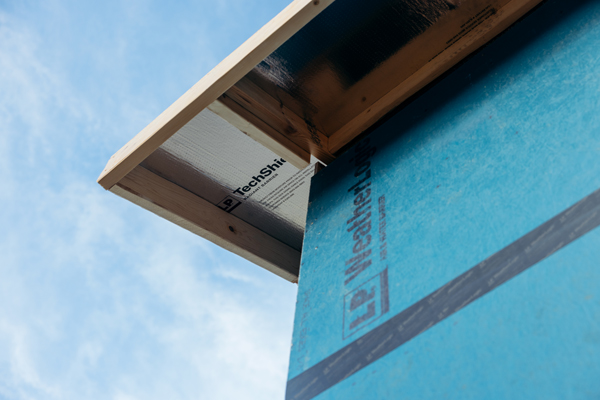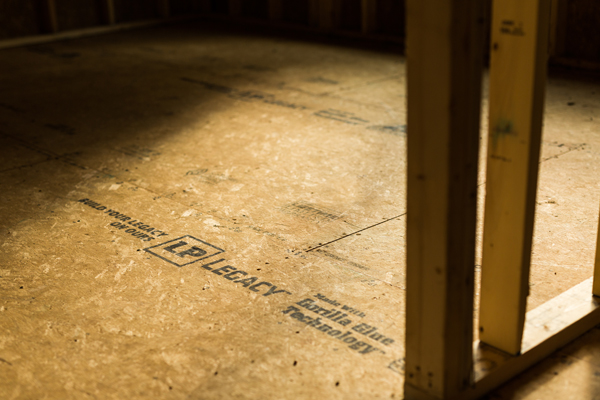Industry Trends9 min
Innovating Carbon-Negative Building Materials for Sustainable Construction
As the demand for sustainable and environmentally friendly homes continues to rise, builders are actively seeking innovative building solutions to meet homeowners' needs. LP Building Solutions is at the forefront of this movement, testing and certifying nearly the entire LP® Structural Solutions portfolio as carbon-negative products.
What is carbon negative and why is having a carbon-negative footprint important? Let's dive in and discover how carbon-negative building materials from LP Structural Solutions help contribute to boosting sustainable practices in the construction industry.
What is Carbon Negative?
A product is considered carbon negative when the amount of carbon dioxide (CO2) emitted through the product's lifecycle—including production, use and disposal—is less than the amount of carbon dioxide the product stores from the atmosphere in its lifetime.
Trees capture and store carbon from the atmosphere. "Younger trees actually store more carbon versus older trees," says Lydia McWilliams, sustainability specialist and forestry policy at LP Building Solutions. "Older trees are at max capacity."
Harvested trees continue to store carbon long after they're manufactured into the engineered wood products used in homes and buildings. Since carbon is stored in the products, it's not released into the atmosphere as greenhouse gases. "Rather than emitting carbon, products made from harvested trees store carbon, unlike products like concrete and steel," explains McWilliams.
What is a carbon-negative footprint? Essentially, it's making thoughtful decisions to use products that have a net effect of removing carbon from the atmosphere, rather than adding to it. Carbon-negative building materials, for example, naturally store more carbon in the product than is released during raw material sourcing, manufacturing, distribution and other stages of the building process.
What is the difference between carbon negative and net zero?
Living in a net zero home is an intense approach to energy efficiency. While choosing carbon-negative products reduces carbon emitted into the atmosphere, a net zero energy building is a structure that is able to produce the same amount of energy as it consumes.
Which LP Structural Solutions Products Are Carbon Negative?
"We are super excited to expand our offering of carbon-negative building materials," says McWilliams. "We've done a lot of research, and we have the evidence to show our products do meet the standards of having a carbon-negative impact versus contributing to increasing carbon into the atmosphere."
LP Structural Solutions products that are certified as carbon negative include the core portfolio:

What about our newest product, LP NovaCore™ Thermal Insulated Sheathing?
"It's too new," explains McWilliams. "We require one full year of manufacturing. Once we get past that milestone, we'll be able to collect evidence and proceed with life cycle assessments."
Why Is It Important for LP to Expand Its Carbon-Negative Building Products?
"LP is committed to do the right thing always," says Emily Duncan, corporate brand manager. "It's important to us to minimize emissions, reduce waste, and be more cognizant of the world around us. Part of doing the right thing always is to protect our planet and protect our environment where our LP community and team members live and work each day."
Duncan explains the vision of the company is to take care of the environment. "It's more than just having awesome products that do what they are supposed to do. LP has a commitment to being a leader in the industry, and the world around us really does shape that perspective. We are concerned about the climate and worried about the cost of living and affordable housing. LP has a responsibility as a manufacturer to play a part in that overall picture," says Duncan.
"That leans into all the things we think about when manufacturing our wood products," says McWilliams. "We look at all the steps to ensure we are harvesting these forests correctly, that we are making products that are durable and beneficial to the environment-even looking at what resins and other materials we're using. It's all to ensure we are making the most minimal impact on the environment."
Why is it important to use carbon-negative building products?
Homebuyers across the country are looking for definitive ways to reduce their carbon footprint. Builders can help their clients strive toward carbon negativity by deliberately choosing products that store carbon from cradle to grave.
"We are hearing that homeowners want to do whatever they can to combat the cost of living in an environment impacted by climate change," says Duncan. "Installing LP Structural Solutions products over more energy-intensive products is a big step in helping your customers reduce emissions and their overall carbon footprint."

Longer-lasting durability is another important factor in building a carbon-negative home.
"As a culture, we buy products and expect them to break-a cell phone is a good example of that," says McWilliams. "LP products are built to last. That means we're not having to go back into our forests and our resources to build them again and again. Building a durable product that stands the test of time helps ensure it has the least impact on our environment."
Ways the Industry is Boosting Sustainability Practices
LP has made a commitment to be the leader in manufacturing carbon-negative products and deepening its sustainability practices.
"Currently, we are one of the only manufacturers of carbon-negative building materials," says McWilliams. "One thing that's really great about the wood products industry is that we all try to be better. So, as LP expands our line of carbon-negative products, it pushes our competitors to improve their sustainability practices. Ultimately, our environment wins."
You can learn more about LP's ongoing commitment to sustainability here.
Continue Reading
Resiliency Solutions
5 minIntroducing LP® SmartSide® ExpertFinish® Naturals Collection™: Nature-Inspired Beauty Meets Engineered Performance
We're excited to introduce the LP® SmartSide® ExpertFinish® Naturals Collection™, a bold new addition to our trusted line of engineered wood siding and trim that delivers the warmth and beauty of nature with the advanced protection and performance builders and homeowners expect.
Labor Solutions
5 minChoosing the Right LP® Structural Solutions Product for Your Build
When it comes to building strong, reliable, and high-performing structures, the materials you choose matter. At LP Building Solutions, we understand that every project, whether it's a single-family home or a multifamily development, requires structural components that meet your needs for strength, durability, and efficiency.
Sustainability Solutions
5 minBuilding a More Sustainable Future with LP Building Solutions
In today's world, sustainability is no longer just a buzzword, it's a blueprint for responsible living and smarter building. As the construction industry seeks ways to reduce its environmental footprint, LP Building Solutions is focused on providing innovative building materials for eco-conscious builders to help reshape what it means to build sustainably
News & Stories3 min
History of Partnership with Gary Sinise Foundation
The LP Foundation is a proud partner of the Gary Sinise Foundation, which supports wounded veterans in several ways. You can learn more about the LP Foundation here.